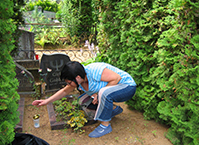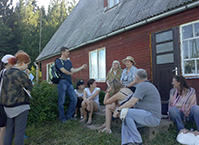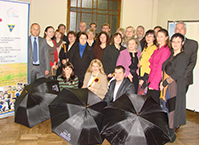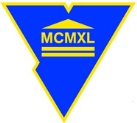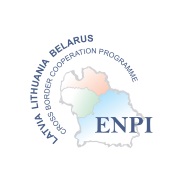E-MUSEUM “VITAMEMORIAE”: COLLECTION AND RESEARCH
Foto
To record people’s life stories, traditions, customs, rituals, rare photographs, old documents, ethnographic differences in funeral rites, etc. the researchers of Daugavpils University and Yanka Kupala Grodno State University carried out field studies in LV and BY territories: in the villages of Krāslava, Rēzekne, Daugavpils regions (Asūne, Foļvarka, Kruki, Skrudaliena, Indra, etc.) and in Belarus (Braslav and Vitebsk districts). The field studies were implemented in the framework of the project “Popularization of the Centres of Oral History in the LV – BY Cross-Border Area”, ID Nr. LLB–2–143, of the Cross Border Cooperation Programme Latvia–Lithuania–Belarus implemented within the framework of the European Neighbourhood and Partnership Instrument 2007–2013.
During the research and the expeditions, the project implementers collected, segmented, transcribed, and digitized the audio-visual materials (audio and video records, photo evidence). To make the collection of the E-Museum more complete, the field researchers and cemetery researchers of Daugavpils University and Grodno University will segment and systematize the audio-visual materials collected during oral history, cemetery research, folklore and dialectology expeditions of the previous years that until now have not been used, aiming at including the best and most valuable segments of the collection into the E-Museum.
The story tellers whose life stories make the input of the E-Museum are people of various generations, mostly elderly people. The childhood of aged people, who at present are about 80 years old, proceeded in the 1930s, therefore the segmented audio-visual units included in the E-Museum chronologically begin from 1929 and can describe only the respondents’ childhood memories. The memory of the older generation is particularly important for the anthropological and historical research – it shifts the time borders, allows for moving to the events of the past through the viewpoints of those who have experienced those times. The facts can be found in chronicles, but what the witnesses of that time can reveal give the memories colour, scent, involve one into mutual emotional experience. The witnesses of the epoch tell about the events form the viewpoint of their own experience.
To motivate the respondents to share their life stories, the project field researchers used Paul Thomson’s oral history research method – enlarged vision of social history where diverse groups of the society are brought together and share common historical experience.
The research basis is the methodology of a semi-structured interview that envisages focused (guided) reconstruction of the past events and an interviewer only helps the respondents to reconstruct the past.
The oral history collection of the E-Museum is envisaged to be used not only by specialists but also by a greatest possible range of non-specialists, therefore, departing from the academic tradition envisaging a complete script and transcript (written transcription of an audio or video record) of life stories, the project experts agreed to segment 360 most vivid, colourful, expressive, unusual, typological or extraordinary audio-visual units (photo, video and audio testimonies) – thematically complete excerpts, and to systematize them according to the thematic plan that would encompass both the historical processes of the 20th century (from the 1920s-30s) and the most essential events of an individual’s life.
ACCESSIBILITY OF THE COLLECTION
The interviews included into the collection are arranged according to the principle of historicism, anthropologism and personalia, indicating the author’s name and the interviewer’s name and surname.
-
Tatiana Nikolayeva: About Kiselev
Zhykhar went there, Klyava, a hero of socialist labor, Vachynskaya, a hero of socialist labor, she has already died, she has orders. I was the only person representing teachers; Semenyaka Ala Gajdis, …
Researcher: Aleksej Zagidulin, Yanka Kupala State University of Grodno
Categories: Study and work, Tatyana Nikolayeva
-
Tatiana Nikolayeva: About mass execution during the war
At our place, in Dubrouna (Vitebsk Oblast) the Germans gathered all the Jews, dag a hole and shot everybody down, and put them into it. On the second day, the people told that the Jewesses put their …
Researcher: Aleksej Zagidulin, Yanka Kupala State University of Grodno
Categories: Confessional and international relations, Tatyana Nikolayeva
-
Tatiana Nikolayeva: German commandant's headquarters
The Germans from the commandant's headquarters spoke some Russian, some German. Their cook was from Check Republic, there were the Germans there, and they changed each other; those who have been at …
Researcher: Aleksej Zagidulin, Yanka Kupala State University of Grodno
Categories: Mode of life, Tatyana Nikolayeva
-
Tatiana Nikolayeva: About war
Nothing was left. The village had been burnt. A German, Willis… We knew the manes of all the Germans. They came, changed each other. Some of them came to the front; some of them were …
Researcher: Aleksej Zagidulin, Yanka Kupala State University of Grodno
Categories: Wartime, Tatyana Nikolayeva
-
Lev Shlyakhter: Canteen
And what was the best delicacy at that time? There was a …
You know what the best delicacy was..., I wrote an application. I had an ulcer of stomach. There was a canteen for dietarians. At …
Researcher: Natalja Ivashchanka, Sviatlana Silava, Yanka Kupala State University of Grodno
Categories: Mode of life, Lev Shlyakhter
-
Lev Shlyakhter: Family
My mother was a woman from Kirovsk, Vyatsk. She worked as a typewriter; she talked on the phone and so on. That’s that.
And what was your sister’s name?
Mine? I don’t have a …
Researcher: Natalja Ivashchanka, Sviatlana Silava, Yanka Kupala State University of Grodno
Categories: Family, Lev Shlyakhter
-
Lev Shlyakhter: Jewish community of Grodno
When you came to Grodno how did get into the Jewish community? Did anybody tell you about it?
Into the community?
Well, when did you began to go to the khesed?
To the khesed?
Yes.
I will tell …
Researcher: Natalja Ivashchanka, Sviatlana Silava, Yanka Kupala State University of Grodno
Categories: Study and work, Lev Shlyakhter
-
Lev Shlyakhter: Games
What games did the children play at that time?
What?
You, when being boys, probably gathered together, and what games did you play?
Lapta, chizhik. How did we play? Several of us had skittles at …
Researcher: Natalja Ivashchanka, Sviatlana Silava, Yanka Kupala State University of Grodno
Categories: First childhood memory, Lev Shlyakhter
-
Lev Shlyakhter: Toys
It appears that you didn’t have any toys in your childhood? Did you have your personal toys?
Toys?
Yes. Such toys as children are given nowadays: cars, teddy bears.
(Laughing).
Weren’ …
Researcher: Natalja Ivashchanka, Sviatlana Silava, Yanka Kupala State University of Grodno
Categories: First childhood memory, Lev Shlyakhter
-
Lev Shlyakhter: Concerts in Magadan
Artists came to our town. For example, Pyekha was paid 80 rubles, other ones were paid 60 or 70 rubles, it depended. It is per concert, besides they paid travel expenses, per diems and so on. Pyekha …
Researcher: Natalja Ivashchanka, Sviatlana Silava, Yanka Kupala State University of Grodno
Categories: Holidays and traditions, Lev Shlyakhter


